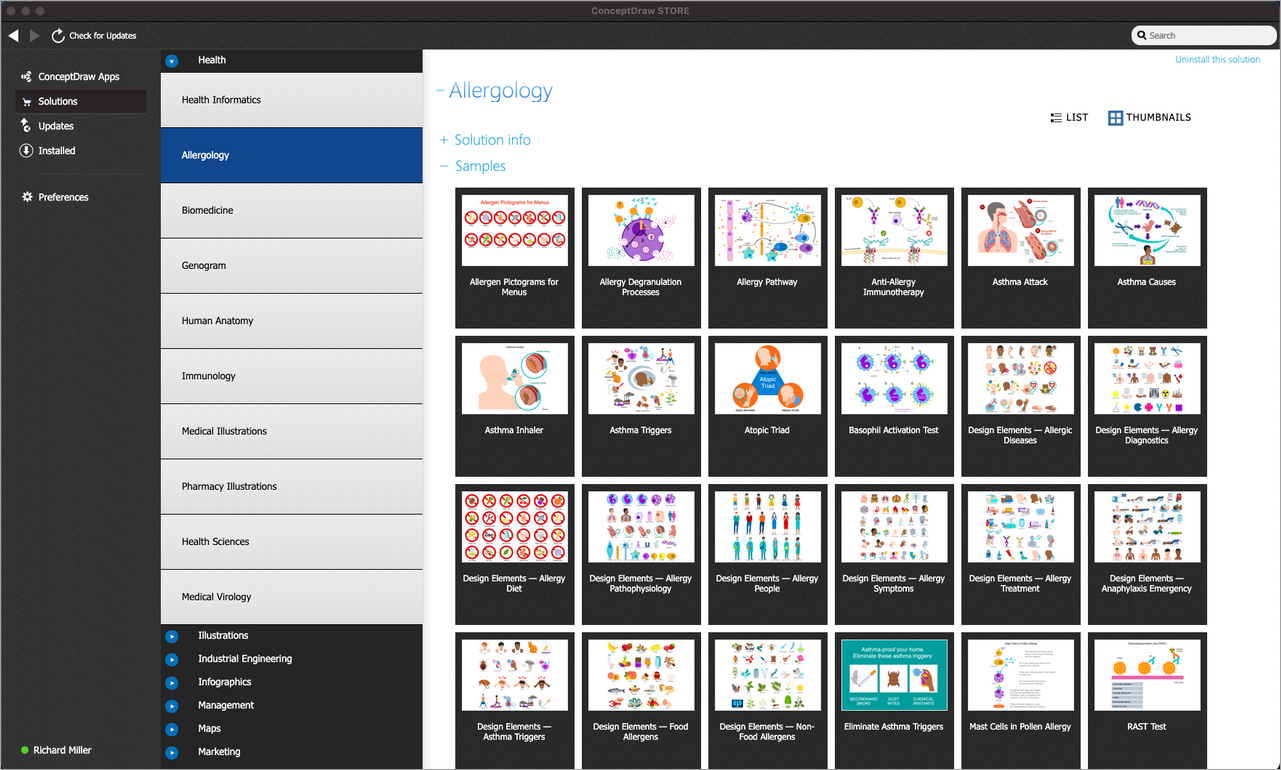- Electric and Telecom Plans Free
- Fire and Emergency Plans Free
- Floor Plans Free
- Plant Layout Plans Free
- School and Training Plans Free
- Seating Plans Free
- Security and Access Plans Free
- Site Plans Free
- Sport Field Plans Free
- Business Process Diagrams Free
- Business Process Mapping Free
- Classic Business Process Modeling Free
- Cross-Functional Flowcharts Free
- Event-driven Process Chain Diagrams Free
- IDEF Business Process Diagrams Free
- Logistics Flow Charts Free
- Workflow Diagrams Free
- ConceptDraw Dashboard for Facebook Free
- Mind Map Exchange Free
- MindTweet Free
- Note Exchange Free
- Project Exchange Free
- Social Media Response Free
- Active Directory Diagrams Free
- AWS Architecture Diagrams Free
- Azure Architecture Free
- Cisco Network Diagrams Free
- Cisco Networking Free
- Cloud Computing Diagrams Free
- Computer Network Diagrams Free
- Google Cloud Platform Free
- Interactive Voice Response Diagrams Free
- Network Layout Floor Plans Free
- Network Security Diagrams Free
- Rack Diagrams Free
- Telecommunication Network Diagrams Free
- Vehicular Networking Free
- Wireless Networks Free
- Comparison Dashboard Free
- Composition Dashboard Free
- Correlation Dashboard Free
- Frequency Distribution Dashboard Free
- Meter Dashboard Free
- Spatial Dashboard Free
- Status Dashboard Free
- Time Series Dashboard Free
- Basic Circle-Spoke Diagrams Free
- Basic Circular Arrows Diagrams Free
- Basic Venn Diagrams Free
- Block Diagrams Free
- Concept Maps Free
- Family Tree Free
- Flowcharts Free
- Basic Area Charts Free
- Basic Bar Graphs Free
- Basic Divided Bar Diagrams Free
- Basic Histograms Free
- Basic Line Graphs Free
- Basic Picture Graphs Free
- Basic Pie Charts Free
- Basic Scatter Diagrams Free
- Aerospace and Transport Free
- Artwork Free
- Audio, Video, Media Free
- Business and Finance Free
- Computers and Communications Free
- Holiday Free
- Manufacturing and Maintenance Free
- Nature Free
- People Free
- Presentation Clipart Free
- Safety and Security Free
- Analog Electronics Free
- Audio and Video Connectors Free
- Basic Circuit Diagrams Free
- Chemical and Process Engineering Free
- Digital Electronics Free
- Electrical Engineering Free
- Electron Tube Circuits Free
- Electronic Block Diagrams Free
- Fault Tree Analysis Diagrams Free
- GHS Hazard Pictograms Free
- Home Automation and Wiring Free
- Mechanical Engineering Free
- One-line Diagrams Free
- Power Сircuits Free
- Specification and Description Language (SDL) Free
- Telecom and AV Circuits Free
- Transport Hazard Pictograms Free
- Data-driven Infographics Free
- Pictorial Infographics Free
- Spatial Infographics Free
- Typography Infographics Free
- Calendars Free
- Decision Making Free
- Enterprise Architecture Diagrams Free
- Fishbone Diagrams Free
- Organizational Charts Free
- Plan-Do-Check-Act (PDCA) Free
- Seven Management and Planning Tools Free
- SWOT and TOWS Matrix Diagrams Free
- Timeline Diagrams Free
- Australia Map Free
- Continent Maps Free
- Directional Maps Free
- Germany Map Free
- Metro Map Free
- UK Map Free
- USA Maps Free
- Customer Journey Mapping Free
- Marketing Diagrams Free
- Matrices Free
- Pyramid Diagrams Free
- Sales Dashboard Free
- Sales Flowcharts Free
- Target and Circular Diagrams Free
- Cash Flow Reports Free
- Current Activities Reports Free
- Custom Excel Report Free
- Knowledge Reports Free
- MINDMAP Reports Free
- Overview Reports Free
- PM Agile Free
- PM Dashboards Free
- PM Docs Free
- PM Easy Free
- PM Meetings Free
- PM Planning Free
- PM Presentations Free
- PM Response Free
- Resource Usage Reports Free
- Visual Reports Free
- House of Quality Free
- Quality Mind Map Free
- Total Quality Management TQM Diagrams Free
- Value Stream Mapping Free
- Astronomy Free
- Biology Free
- Chemistry Free
- Language Learning Free
- Mathematics Free
- Physics Free
- Piano Sheet Music Free
- Android User Interface Free
- Class Hierarchy Tree Free
- Data Flow Diagrams (DFD) Free
- DOM Tree Free
- Entity-Relationship Diagram (ERD) Free
- EXPRESS-G data Modeling Diagram Free
- IDEF0 Diagrams Free
- iPhone User Interface Free
- Jackson Structured Programming (JSP) Diagrams Free
- macOS User Interface Free
- Object-Role Modeling (ORM) Diagrams Free
- Rapid UML Free
- SYSML Free
- Website Wireframe Free
- Windows 10 User Interface Free
Allergology
Allergology is the branch of medicine studying allergies and immune system hypersensitivity. Allergology deals with issues related to the prevention, diagnosis and treatment of various types of allergies, learning conditions and triggers. Allergy is an abnormal and specific reaction of the immune system caused by an increased sensitivity to certain substances. It triggers the body's immunological mechanisms and causes an excessive immune response to substances foreign to the body. This is why allergology is closely related to immunology. Allergy is a truly unpleasant condition that greatly affects the general well-being of people exposed to it. Allergies reduce quality of life, concentration, information perception, productivity, learning ability, etc.
Substances that cause hypersensitivity of the body, that is, causing an allergic reaction, are called allergens. They are usually harmless to most people, but dangerous for allergy sufferers. There are different types of allergies like seasonal, food, dust, medication, etc., depending on the allergens causing them. The most common allergens are pollen, food, animal hair, dust, mold, food, mites, insect venom. Hypersensitivity of the body with allergies to certain substances is associated with immunoglobulins E (IgE). The body produces specific antibodies IgE when first encounters allergens. When exposed to such allergens in the future, these antibodies trigger the release of certain chemicals by immune cells, mast cells, and basophils. These chemicals like histamine, chemokines, proteases, heparin, in particular histamine, cause an overreaction of blood vessels, smooth muscle tissue, and allergic symptoms.
A range of allergy symptoms is sufficiently wide and includes rashes, itchiness, hives, redness of the skin and eyes, runny nose, tearing, swelling, vomiting. According to the symptoms, their severity, causes, and affected parts of the body, the allergic conditions are differentiated. One differs the allergic rhinitis, atopic eczema, allergic conjunctivitis, food allergy, medication allergy, asthma, anaphylaxis, etc.
The effectiveness of managing and treatment of allergic diseases in most depends on the ability to make an accurate diagnosis. Among the common diagnostics methods of the allergy are the external inspection of the patient and different kinds of allergy testing like allergy blood testing, skin prick testing, patch testing. Allergy testing helps to exclude or confirm allergies, and detect the kinds of allergens causing a problem for a certain person. Each of these methods has a high diagnostic value.
Allergology solution supplies the ConceptDraw DIAGRAM with powerful functionality and drawing tools for designing illustrations, diagrams, schematics, presentation slides, and infographics on the subject of allergology. The solution includes a large collection of pre-designed vector allergen pictograms, images and clipart, likewise a set of professionally designed samples. They are useful for illustrating prevention methods, allergy testing methods, and the treatment of allergic diseases. Use these tools to describe the latest research and technology in allergy and to illustrate a typical allergic reaction for each type of allergy. Easily depict ways to manage various allergic reactions, including seasonal allergies, food allergies, drug allergies, pet allergies, and many other types of allergies. This solution will benefit all healthcare professionals and healthcare professionals, especially allergists and immunologists.
-
Buy this solution $49 -
Solution Requirements - This solution requires the following products to be installed:
ConceptDraw DIAGRAM v18 - This solution requires the following products to be installed:
-
Compatibility - Sonoma (14), Sonoma (15)
MS Windows 10, 11 - Sonoma (14), Sonoma (15)
-
Support for this Solution -
Helpdesk
The Allergology solution contains 15 examples and 11 libraries containing 300 vector graphics and icons, to allow you to create professional-looking documents.
Design Elements — Allergic Diseases
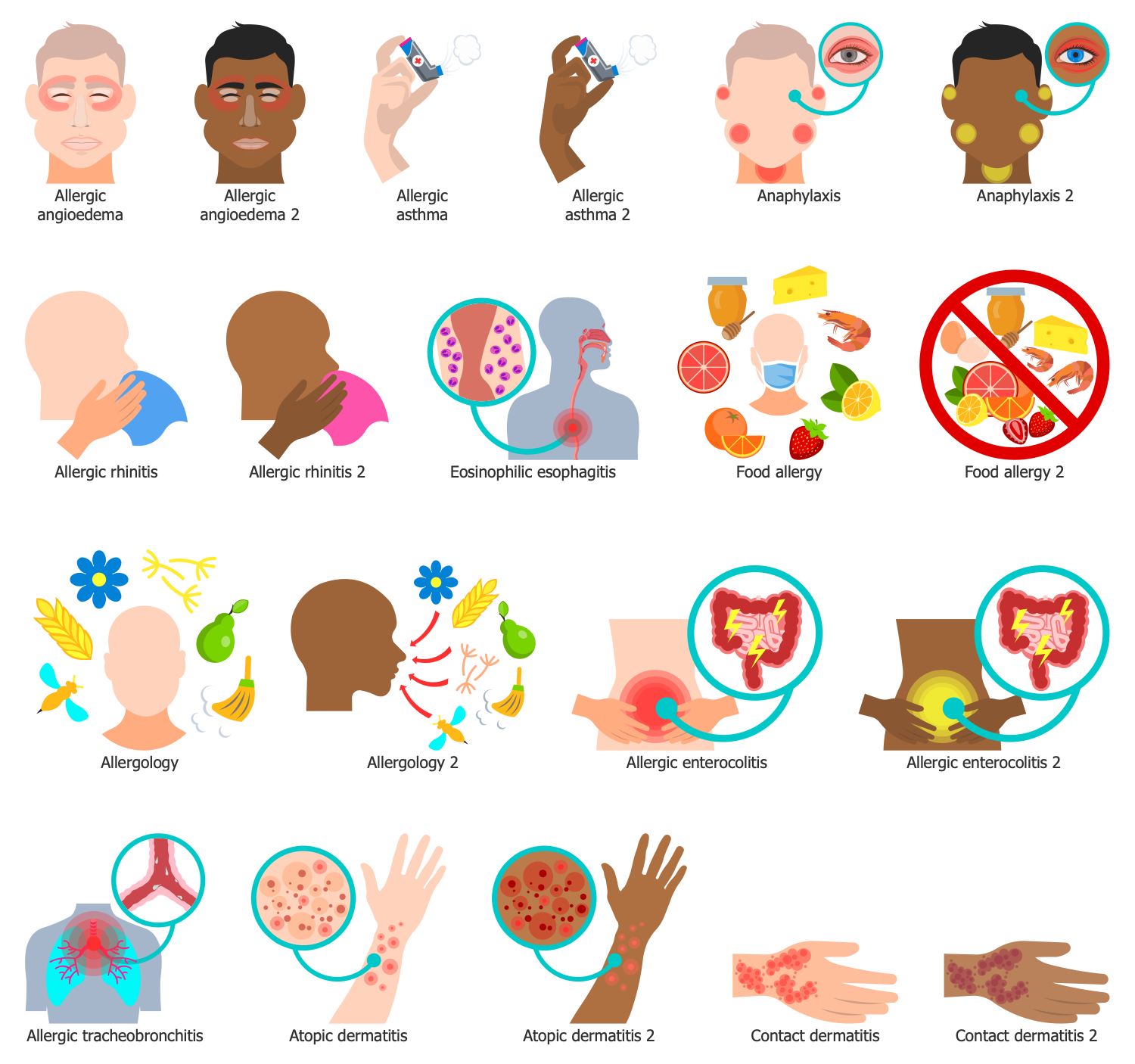
Design Elements — Allergy Diagnostics
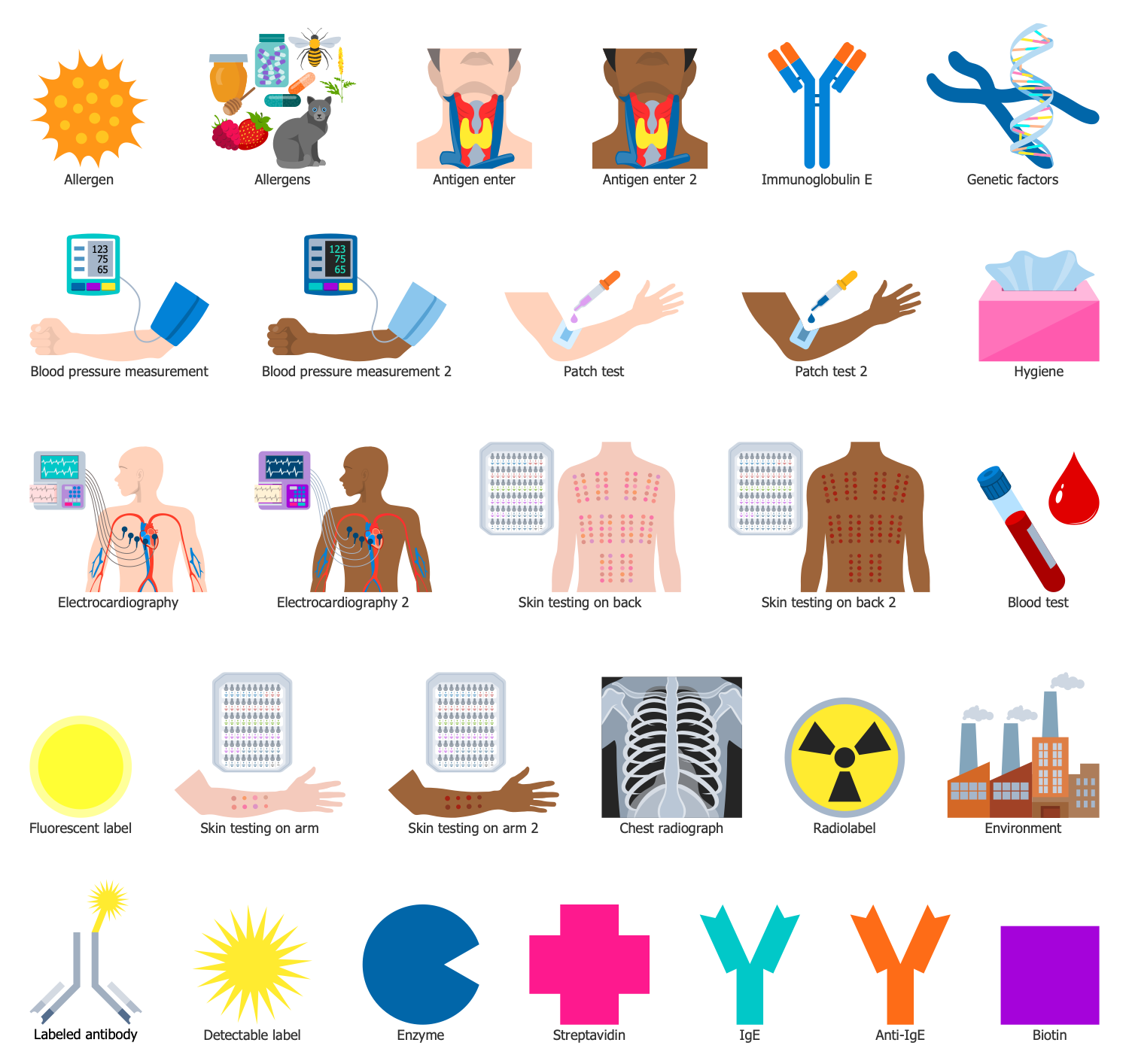
Design Elements — Allergy Diet
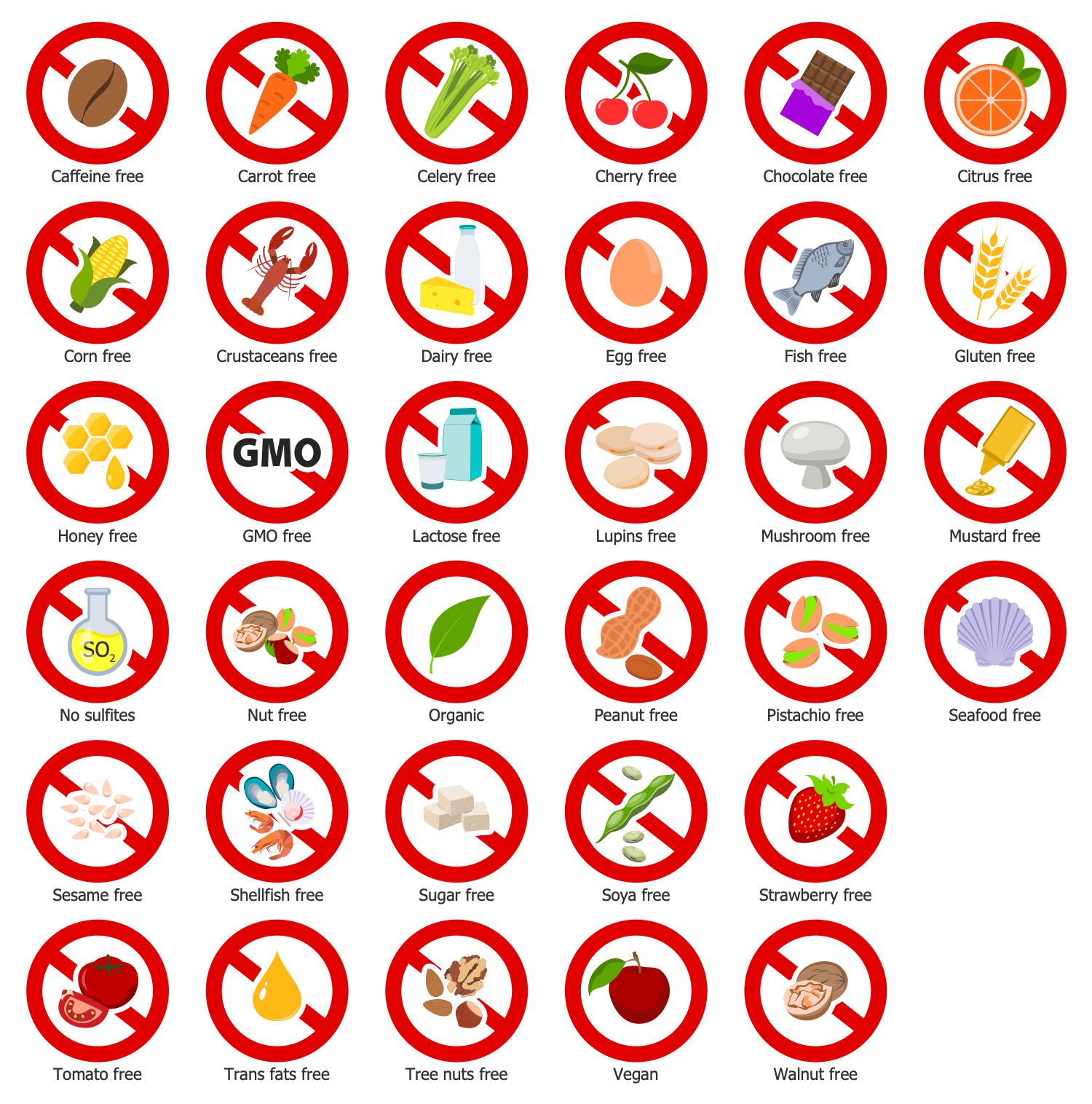
Design Elements — Allergy Pathophysiology
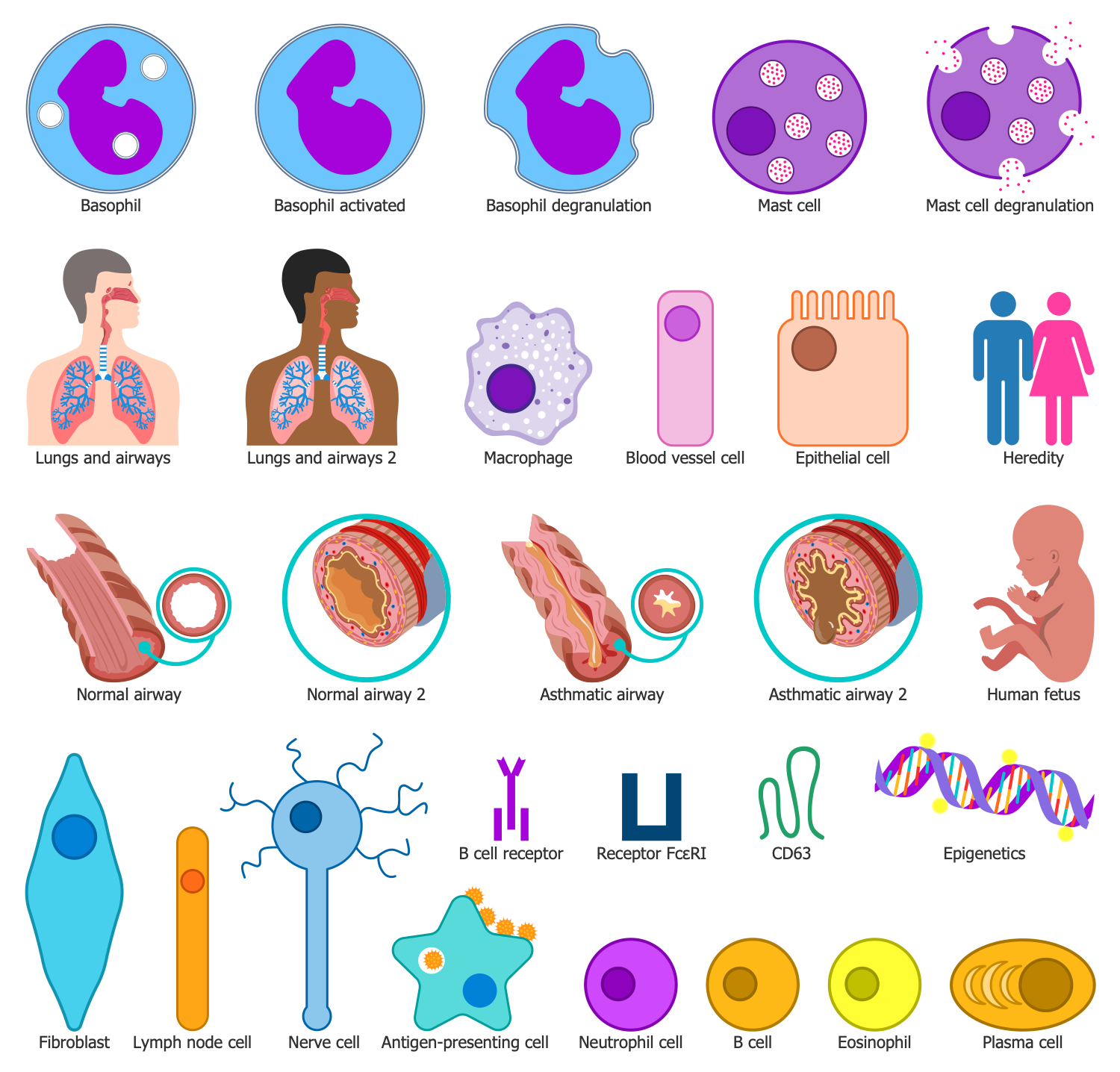
Design Elements — Allergy People

Design Elements — Allergy Symptoms
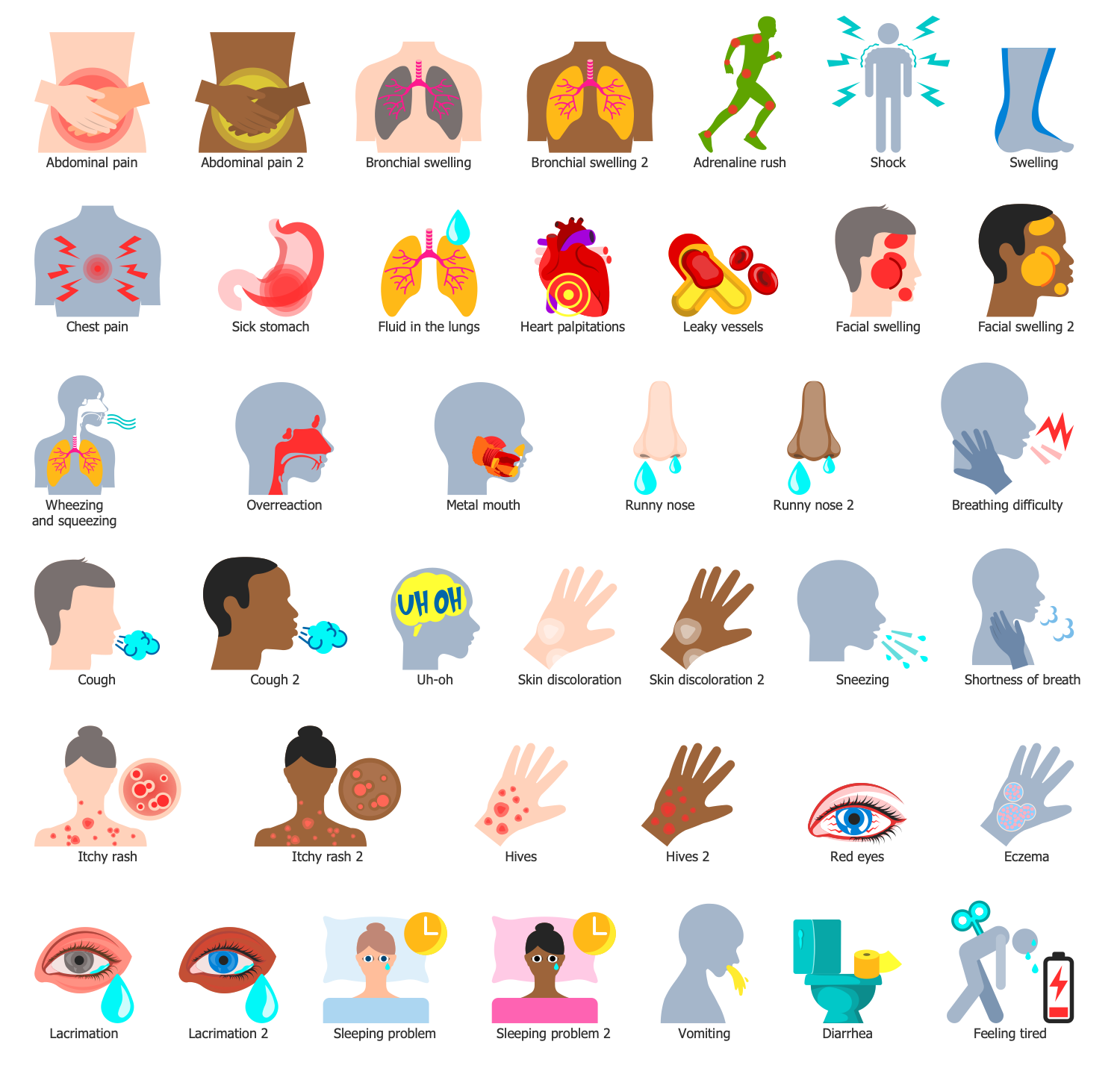
Design Elements — Allergy Treatment
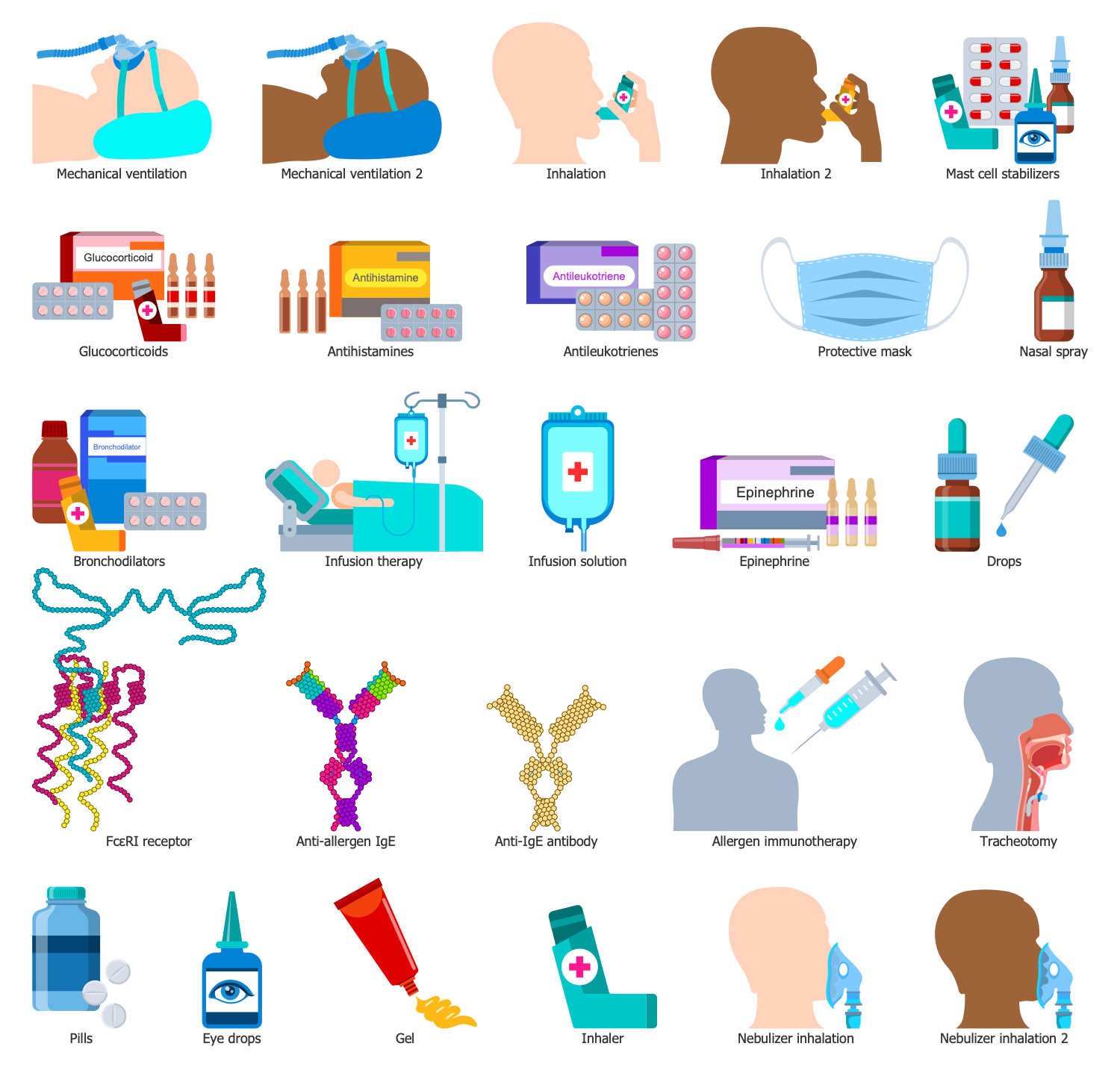
Design Elements — Anaphylaxis Emergency
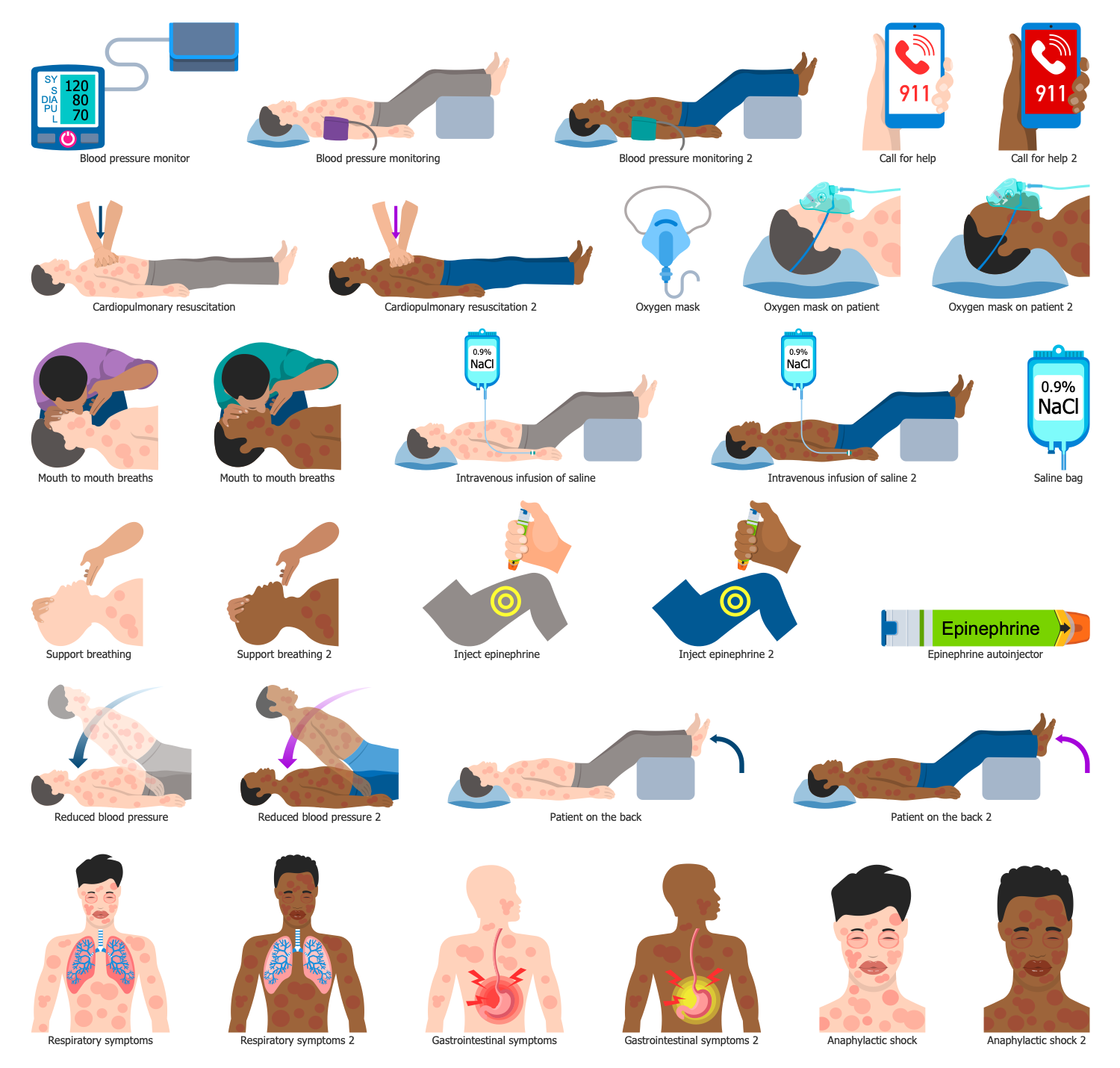
Design Elements — Asthma Triggers

Design Elements — Food Allergens

Design Elements — Non-Food Allergens
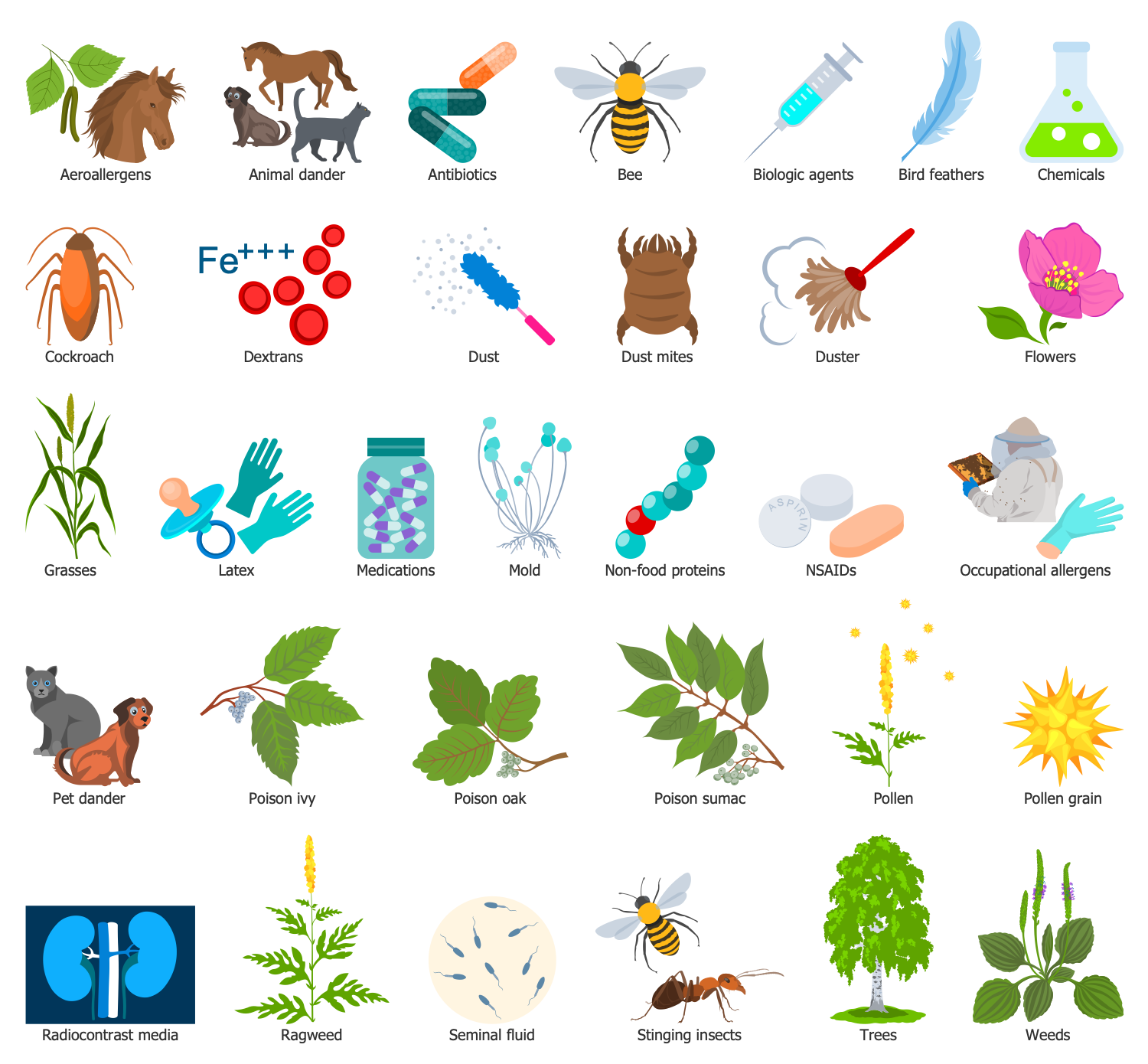
Related News:
Examples
There are a few samples that you see on this page which were created in the ConceptDraw DIAGRAM application by using the Allergology solution. Some of the solution's capabilities as well as the professional results which you can achieve are all demonstrated here on this page.
All source documents are vector graphic documents which are always available for modifying, reviewing and/or converting to many different formats, such as MS PowerPoint, PDF file, MS Visio, and many other graphic ones from the ConceptDraw Solution Park or ConceptDraw STORE. The Allergology solution is available to all ConceptDraw DIAGRAM users to get installed and used while working in the ConceptDraw DIAGRAM diagramming and drawing software.
Example 1: Allergen Pictograms for Menus
This diagram was created in ConceptDraw DIAGRAM using the combination of libraries from the Allergology Solution. An experienced user spent 5 minutes creating this sample.
This sample shows the typical allergen pictograms used in the menu. Food allergy is the most common type of allergy. This represents an abnormal immune response to certain foods, where immunoglobulin E (IgE) binds to food molecules. This triggers the release of certain chemicals like histamine. An allergic reaction occurs within minutes or hours of contact with a food allergen. Its severity can range from mild to severe. Common symptoms may include itching, hives, and rash, swelling of the tongue, vomiting, difficulty breathing, or anaphylaxis. Common food allergens are present, including gluten, seafood, eggs, fish, peanuts, soy, lactose, walnuts, celery, mustard, sesame seeds, sulfites, lupines, and shellfish. Usually the problem arises from the protein in the food. Risk factors for food allergies include heredity, obesity, vitamin D deficiency, and a few others. Food allergies are more common among children than adults, but some allergies disappear with age. To eliminate negative effects on the body, it is recommended to avoid certain foods.
Example 2: Degranulation Processes
This diagram was created in ConceptDraw DIAGRAM using the combination of libraries from the Allergology Solution. An experienced user spent 10 minutes creating this sample.
This sample shows the degranulation process. It is a cellular process during which antimicrobial cytotoxic or other molecules are released from granules located within cells. Various cells of the immune system, like granulocytes, neutrophils, basophils, eosinophils, and mast cells, use the degranulation process. This sample shows the degranulation process of allergy in the mast cell. Mast cells are immune regulatory cells involved in inflammation. You can see how allergens interact with IgE molecules bound to Fc receptors on the surface of mast cells. Mediators like histamine, proteases, chemokines, heparin are stored in large quantities in the cytoplasmic granules of mast cells. During degranulation, these preformed mediators are released from mast cells. Newly formed mast cell mediators include prostaglandins, leukotrienes, thromboxanes, and PAF. The schematic legend clearly describes all the components of the illustrated process.
Example 3: Allergy Pathway
This diagram was created in ConceptDraw DIAGRAM using the combination of libraries from the Allergology Solution. An experienced user spent 15 minutes creating this sample.
This sample shows the key events causing an allergy and how it develops in an organism. It is a complex process, but a visual illustration makes it easier for perception and comprehension. At the first stage, you see the allergen entering a body (A). An antigen-presenting cell joins the allergen molecules and then uses the MHC II receptors onto its surface to present the epitopes (B). The activated antigen moves to the lymph node and activates T cells recognizing the allergen (C). Then the T cells are differentiated into Th2 cells. B cells recognize the allergen activated through the Th2 cells (D). The activated B cells differentiate into plasma cells (E). The antibodies of the IgE isotype are synthesized and circulate in the lymphatic and cardiovascular systems (F). Further, they bind on mast and basophil cells (G). Being re-entering into the body, the allergen is recognized and bound to the IgE. As a result of the aggregation, the pre-formed mediators like histamine and IL-4 are released. The histamine causes common allergy symptoms like redness, itchiness, swelling, heat, pain. The IL-4 affects the production of more B cells and IgE.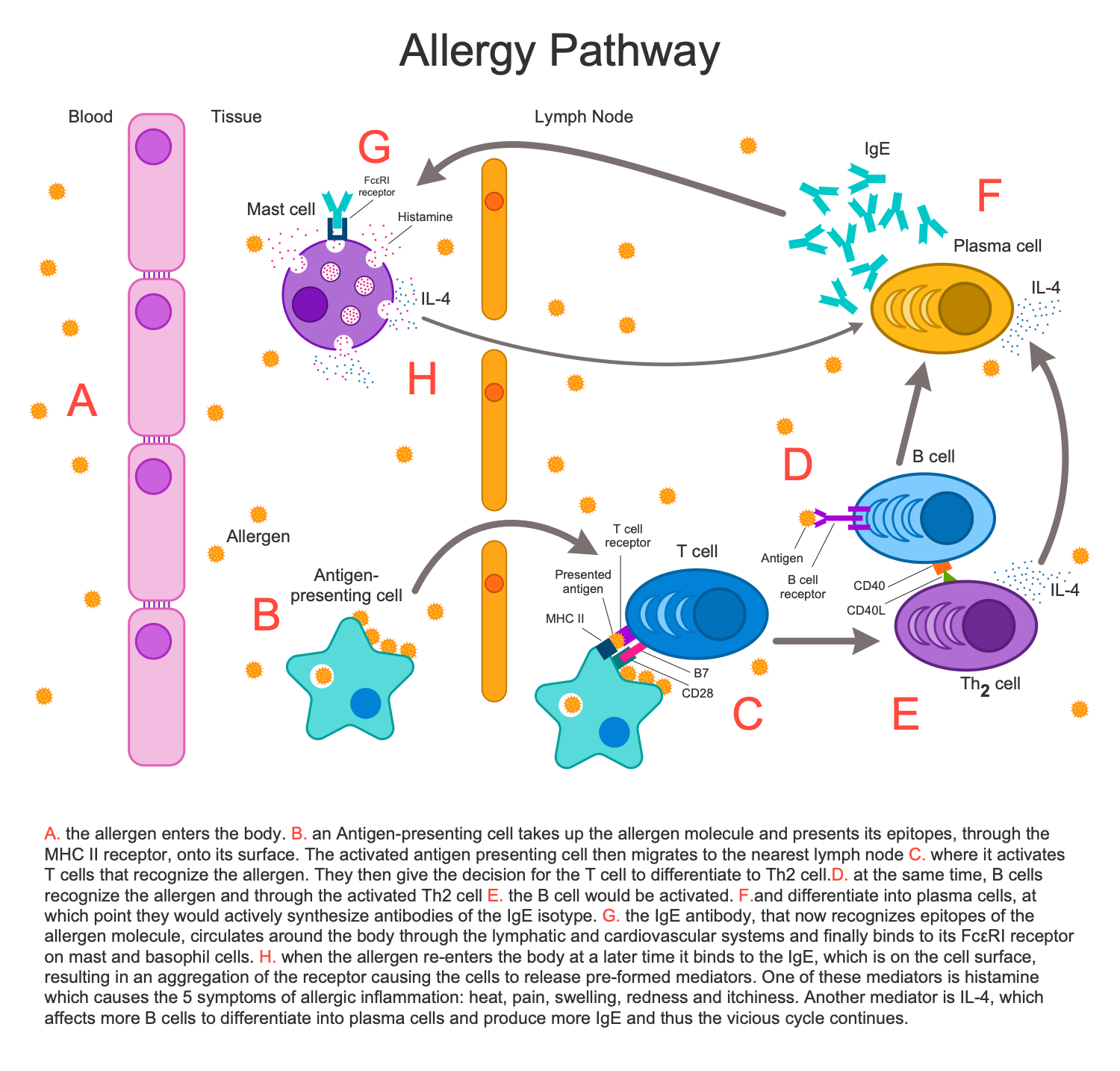
Example 4: Anti-allergy Immunotherapy
This diagram was created in ConceptDraw DIAGRAM using the combination of libraries from the Allergology Solution. An experienced user spent 10 minutes creating this sample.
There are several ways to deal with allergies. These include preventing allergy triggers, using medications to treat allergy symptoms, immunotherapy, and alternative medicine. This sample is dedicated to anti-allergic immunotherapy. It is a treatment for certain types of allergic disorders. Anti-allergic immunotherapy is effective for insect bites and pollen allergies, environmental allergies, allergic rhinitis, conjunctivitis, and asthma. It supposes the exposure more and more of the allergen in the form of injections of allergens under the skin. Injections of IgE antibodies bind free IgE and IgE on the surface of B cells. This signals the destruction of IgE. As a result, the immune system's response to this allergen gradually changes. The allergic reaction to the allergen is completely stopped or the severity of the disease decreases. Anti-allergic immunotherapy is a fairly effective and safe method, the effect lasts for many years after treatment.
Example 5: Asthma Attack
This diagram was created in ConceptDraw DIAGRAM using the combination of libraries from the Allergology Solution. An experienced user spent 15 minutes creating this sample.
Asthma is an inflammatory disease of the airways. Asthma disease is characterized by variable and recurring symptoms, bronchospasms, bronchoconstriction, tightening of respiratory smooth muscle, inflammation of respiratory tubes, and reversible airflow obstruction. Among the major symptoms are coughing, wheezing, chest tightness, difficult breathing, and shortness of breath. The attacks may occur from a few times per week to a few times a day depending on the severity of the disease. The external stimuli, environmental triggers, allergens, increased physical activity can influence. The feeling can also worse at night. Figure A shows the respiratory system, the location of airways and lungs in a body. Two states of airways are shown in figures B and C. You can compare a cross-section of a normal airway and during asthma symptoms. Turn attention to how the airways narrow during the asthma attack, excess mucus is produced and causes difficulty of breathing.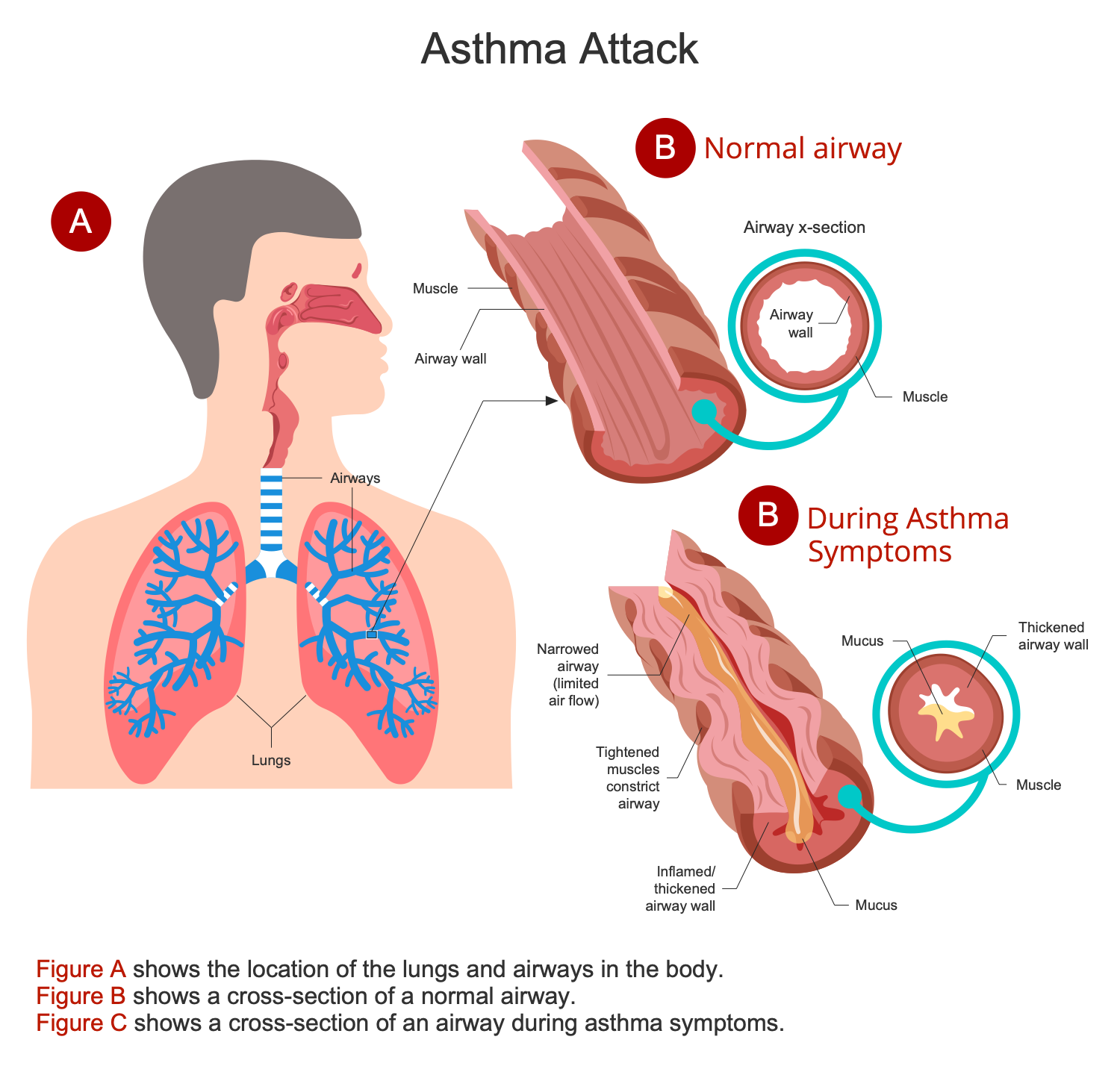
Example 6: Asthma Causes
This diagram was created in ConceptDraw DIAGRAM using the combination of libraries from the Allergology Solution. An experienced user spent 10 minutes creating this sample.
This sample diagram shows common causes of asthma, including genetics, epigenetics, and environmental factors. Genetic causes suggest the presence of certain changes or mutations in the genes of the parents. They make the child get rid of various diseases, including asthma. The causes of epigenetics are also associated with genes, with their work, but not with changes in genes in DNA. Epigenetic changes are caused by infections like respiratory infections, diets, chemicals, medications, etc. They are inherited from one or two generations, rather than forever from each generation. Epigenetic changes can occur in a baby within its mother or later after birth. Among the environmental factors causing disease, there are many adverse effects like air and water pollution, cigarette smoke, insects, and others. Having a genetic predisposition to asthma or epigenetic changes in genes and suddenly finding themselves in adverse conditions, one is more likely to develop asthma.
Example 7: Asthma Inhaler
This diagram was created in ConceptDraw DIAGRAM using the combination of libraries from the Allergology Solution. An experienced user spent 5 minutes creating this sample.
Asthma is a serious and life-threatening chronic respiratory disease occurring among adults and children. This disease greatly affects the quality of life. Medical treatment and special medications are used in asthma disease control. This sample shows a patient with asthma taking medication using an inhaler. Asthma inhalers are hand-held portable devices used to deliver medications to the lungs of an asthma patient. They are indispensable to prevent and treat asthma attacks. There are different kinds of inhalers. Typically, an inhaler has a boot shape and includes a pressurized canister with medication. This medication is released by simple pushing the canister into the boot. A correct type of inhaler is chosen individually by a physician along with medication, There are devices with the different quantity of doses, automatic medication release at the inhale, built-in dose counters, or without them. The normal airways and ones of an asthma patient greatly vary. You can observe both states of airways in a diagram and compare them.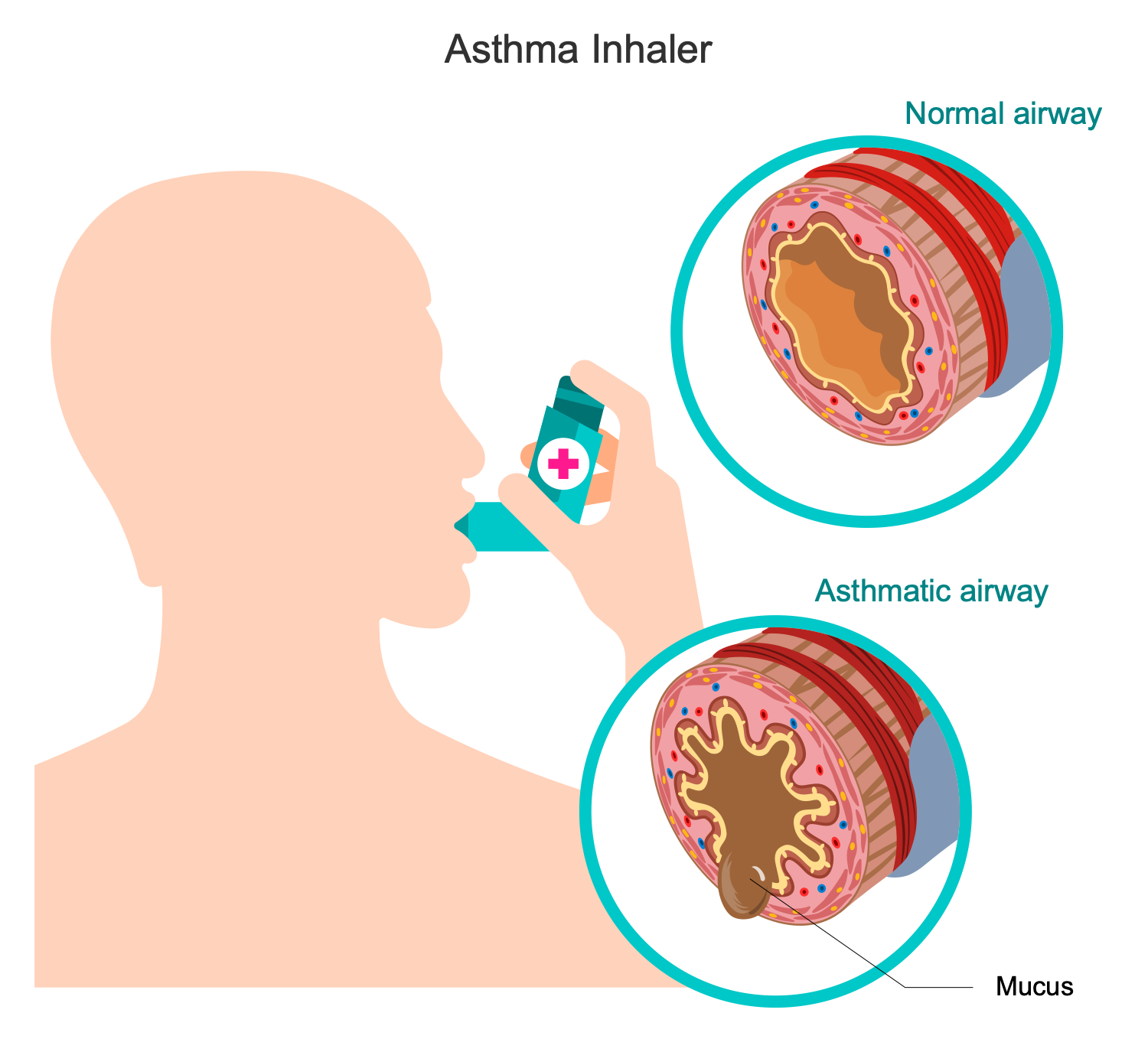
Example 8: Asthma Triggers
This diagram was created in ConceptDraw DIAGRAM using the combination of libraries from the Allergology Solution. An experienced user spent 10 minutes creating this sample.
This sample shows a variety of asthma trigger factors or triggers. These are the things and factors capable to worse the feeling of a person with asthma. They can cause the appearance of asthma signs and symptoms and even trigger an attack. The most common asthma triggers are pets, pollen, fungus spores, stress, strong odors, anger, dust, cold air, pollution, smoke, exercises, chemical fumes, and bugs in the home. All these factors are shown in a diagram with the corresponding clipart. These triggers can act as irritants for an individual with asthma. Having this disease it is necessary to be really attentive, to limit or in ideal to stop the contact with these factors. For example, the impact of tobacco smoke is significant even from a burning cigarette, you don't even need to smoke it yourself, it is enough to be beside a smoking person. The outdoor air pollution is stronger near the factories and refineries, and it is recommended to avoid these areas. When it is impossible to totally avoid the asthma triggers, it is required to correct behavior, be vigilant and on the lookout.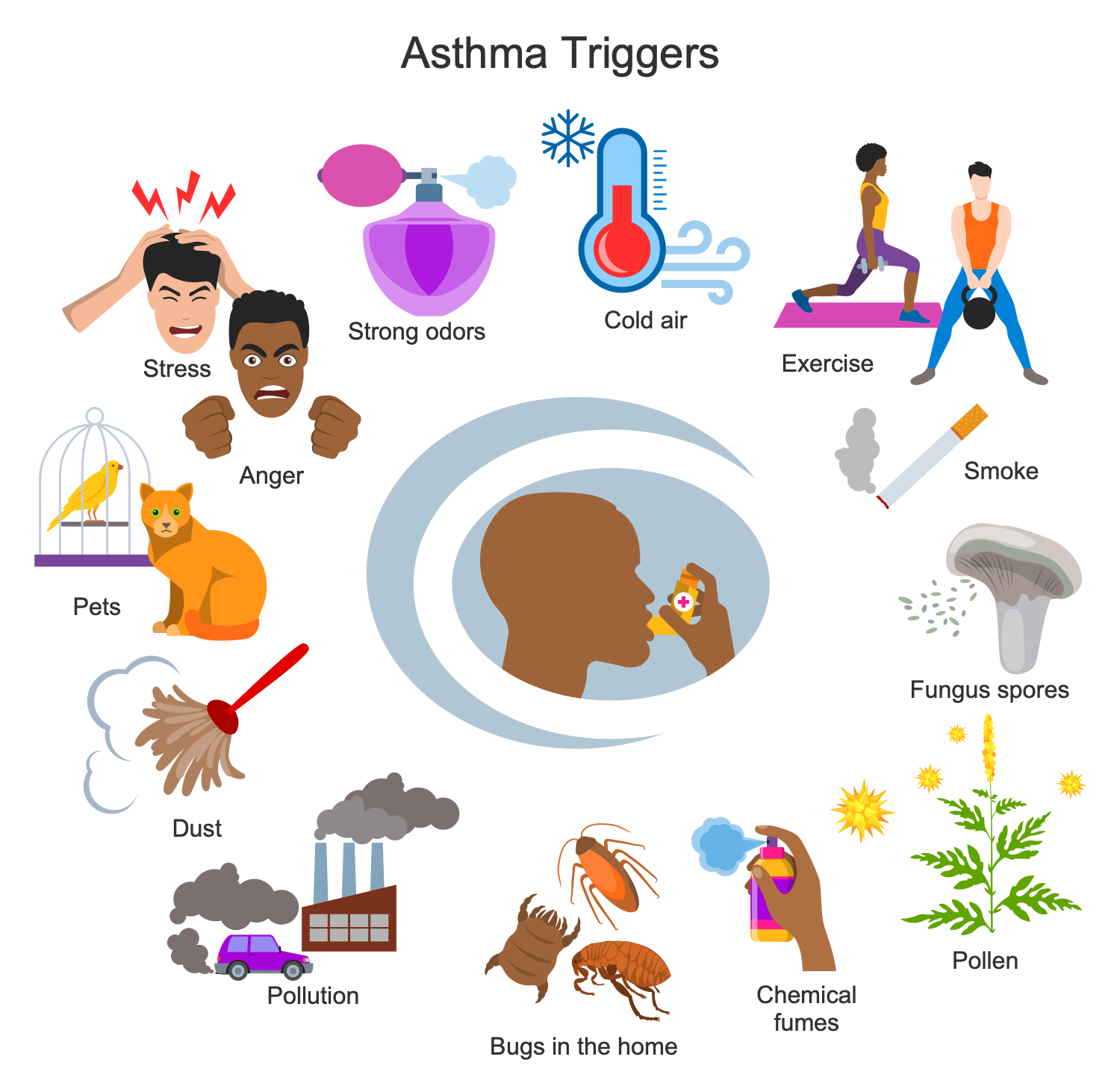
Example 9: Atopic Triad
This diagram was created in ConceptDraw DIAGRAM using the combination of libraries from the Allergology Solution. An experienced user spent 5 minutes creating this sample.
This sample illustrates the atopic triad. It shows three associated allergy-related medical conditions: atopic asthma, atopic dermatitis, and allergic rhinitis. Atopy term comes from Greek and means "the state of being out of place" or "absurdity". It is a tendency of an organism to produce an excessive IgE immune response to harmless substances in the environment. Typically atopy occurs at the second direct contact with the allergen, but can also have a hereditary beginning. A lot of substances can act as allergens in certain conditions, these are foods, pollen, dust mites, dander, etc. At the inappropriate atopic or allergic reaction of an organism, the initially harmless substance comes as an allergen and activates B cells. These cells begin production of specific IgE antibodies in a large amount. At the first facing with an allergen, these IgE antibodies bind to the mast cells. The re-exposure of the allergen activates the mast cells and causes releasing of powerful chemical mediators like histamine, cytokines. The atopic responses can have different severity.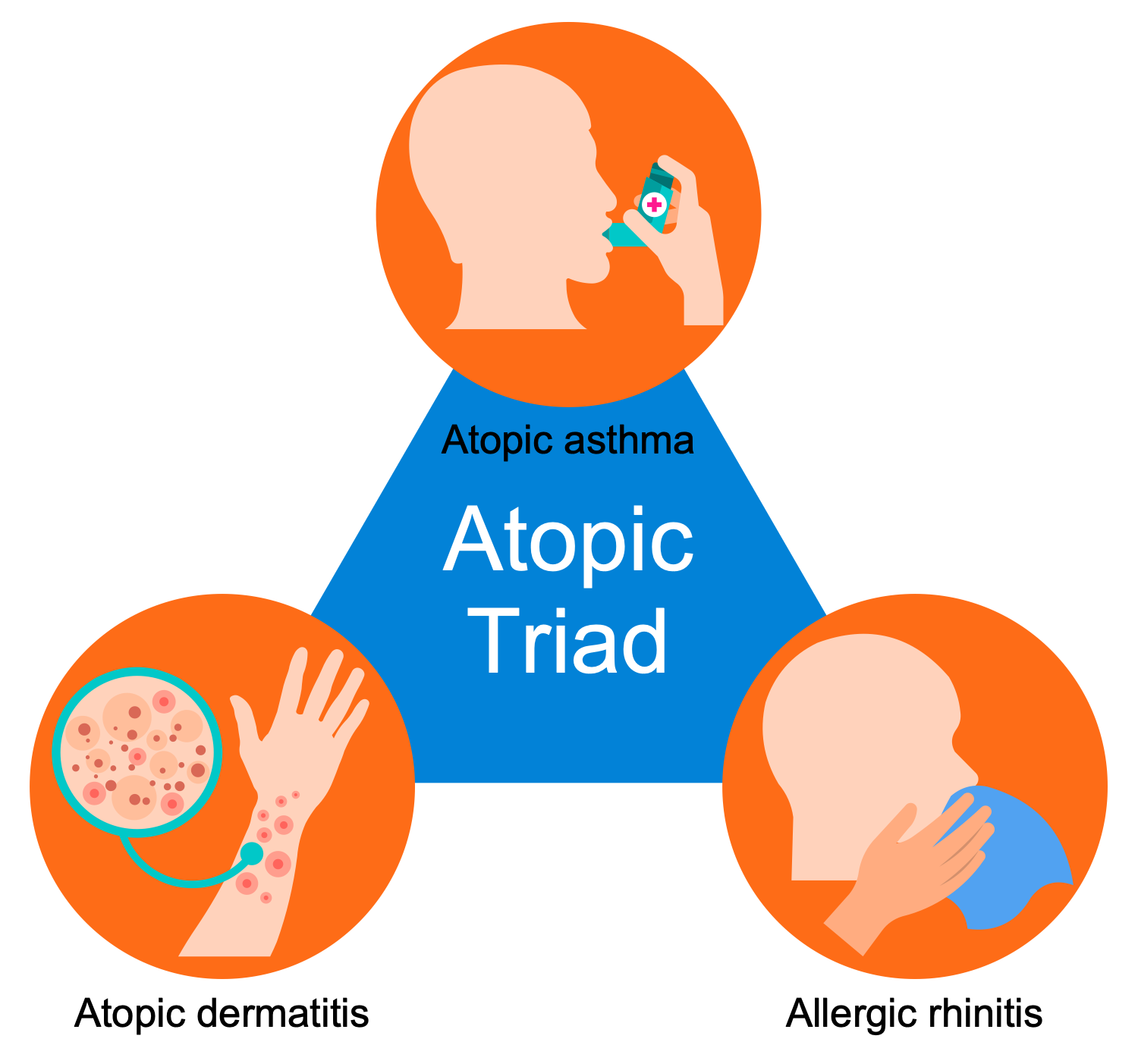
Example 10: Basophil Activation Test
This diagram was created in ConceptDraw DIAGRAM using the combination of libraries from the Allergology Solution. An experienced user spent 10 minutes creating this sample.
This sample shows the basophil activation test. It includes 6 steps and is an in vitro method for the diagnosis of hypersensitivity. It is based on the registration of markers of activation and degranulation of basophils after their activation by allergens. The basophils and mast cells are key cells involved in allergic reactions. The basophils contain the receptors FcεR for the immunoglobulin IgE. Being activated in a body by released histamine, they cause common allergic symptoms. The basophils include a lot of granules in their composition. These granules contain active substances and as a result of the degranulation process, they incite an allergic response. When the IgE antibody is bound to an allergen, the basophils are activated and start degranulation. The addition of labeled antibodies CD63 markers after degranulation allows overseeing how the markers bind to the CD63 proteins on the cell membranes of the basophils. ConceptDraw DIAGRAM software is ideal for the visual representing the results of allergy testing.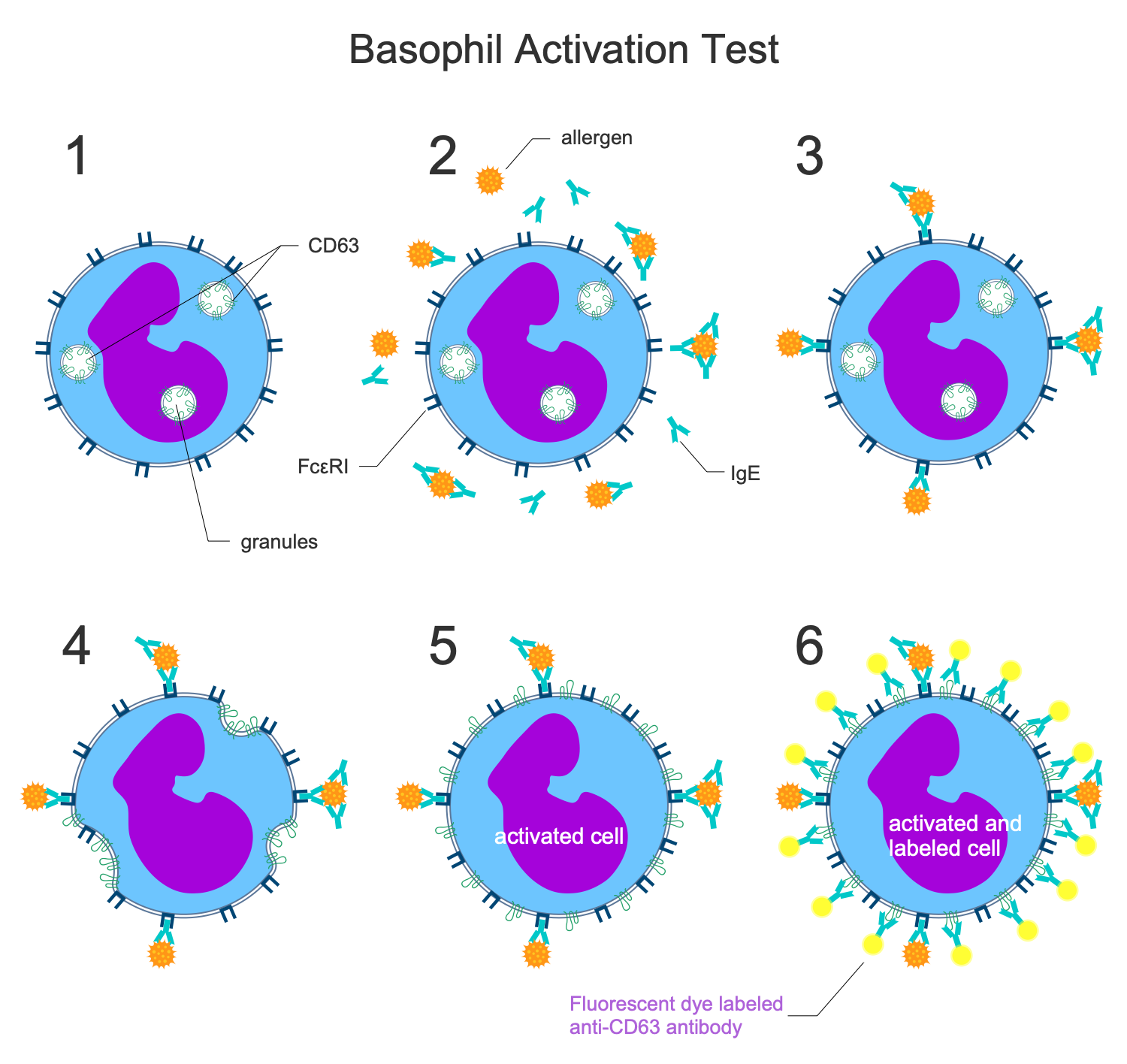
Example 11: Eliminate Asthma Triggers
This diagram was created in ConceptDraw DIAGRAM using the combination of libraries from the Allergology Solution. An experienced user spent 5 minutes creating this sample.
This example shows the main triggers for asthma. As you fight asthma and protect your health, these triggers need to be addressed. The main triggers of asthma include secondhand smoke, dust mites, and chemical irritants. Passive smoking is the smoke of tobacco, cigarettes, cigars, pipes. It contains many substances harmful to the human body. These substances can cause asthma attacks and increase the severity of asthma attacks. Dust mites are tiny insects living in house dust and feed on human skin scales. They pose a serious threat to people with a predisposition to asthma. Body parts and excrement from dust mites can trigger asthma attacks. Another important group of asthma triggers is chemical irritants. They are found in cleaning products, air fresheners, cosmetics, adhesives, paints, pesticides, and other products used by people to clean their homes, fertilize, and care for plants.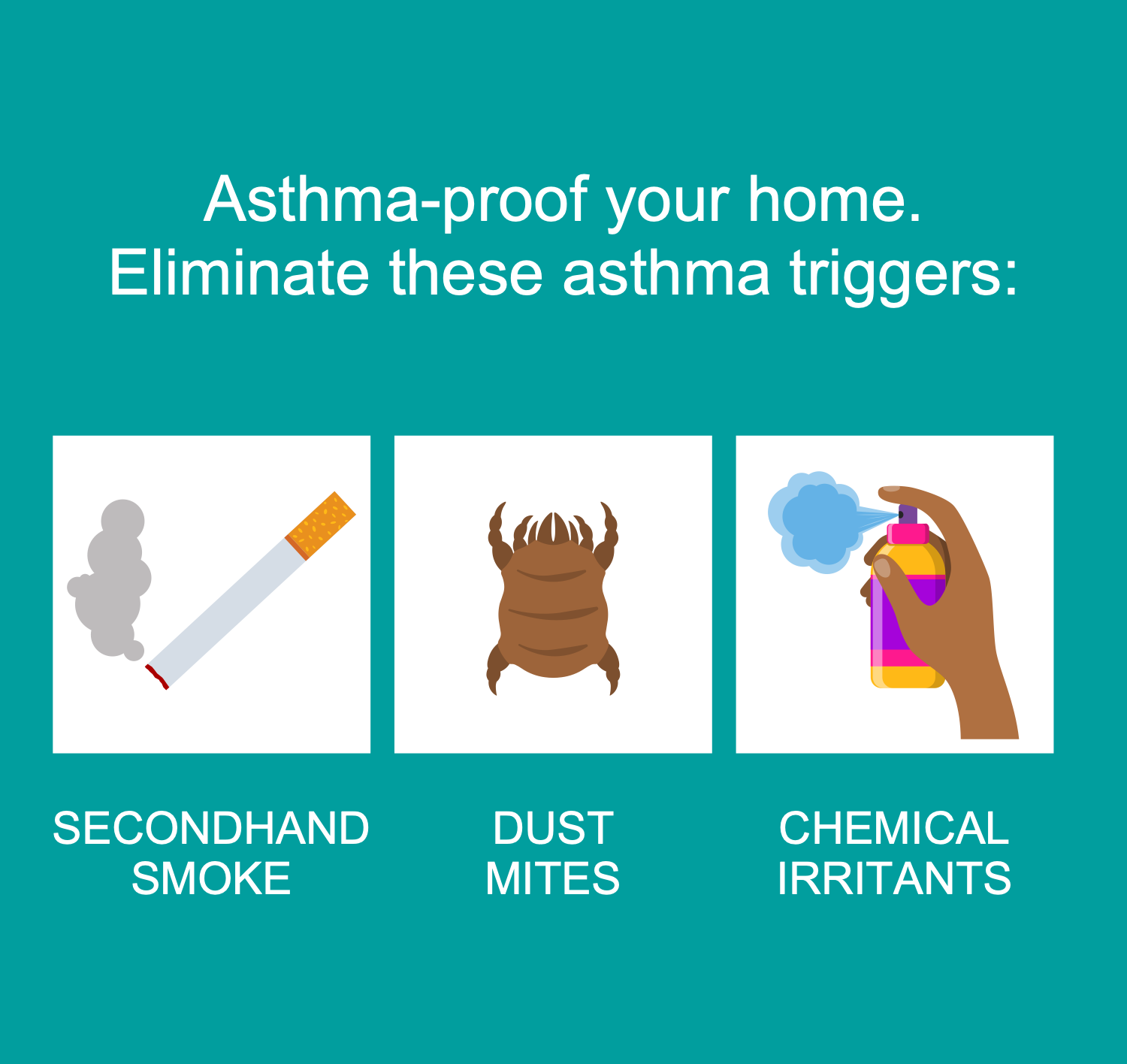
Example 12: Mast Cells in Pollen Allergy
This diagram was created in ConceptDraw DIAGRAM using the combination of libraries from the Allergology Solution. An experienced user spent 15 minutes creating this sample.
Various allergies, including seasonal allergies, pollen allergy, are associated with IgE antibodies. IgE levels rise in the blood or locally in the nasal mucosa in response to a pollen allergen. All IgE antibodies are specific for the recognition of allergens: some act against ragweed pollen, others against birch pollen, and still others against poplar, oak, etc. This sample shows the mast cells involved in ragweed pollen allergy and their role in the development of allergies. A ragweed pollen allergy is a type of seasonal allergy. Mast cells are connective tissue cells containing granules rich in histamine and heparin. Powerful chemicals like histamine, leukotrienes, cytokines, interleukins, and more, secreted by mast cells, cause typical allergy symptoms. Among them — local inflammation, narrowing of the airways, increased mucus secretion, increased vascular permeability. When a person with an allergy predisposition first encounters an allergen, their body activates B cells and produces large amounts of the corresponding IgE antibodies. These IgE molecules attach to mast cells. The second time that person encounters the same allergen, the IgE-primed mast cells release chemical mediators and granules.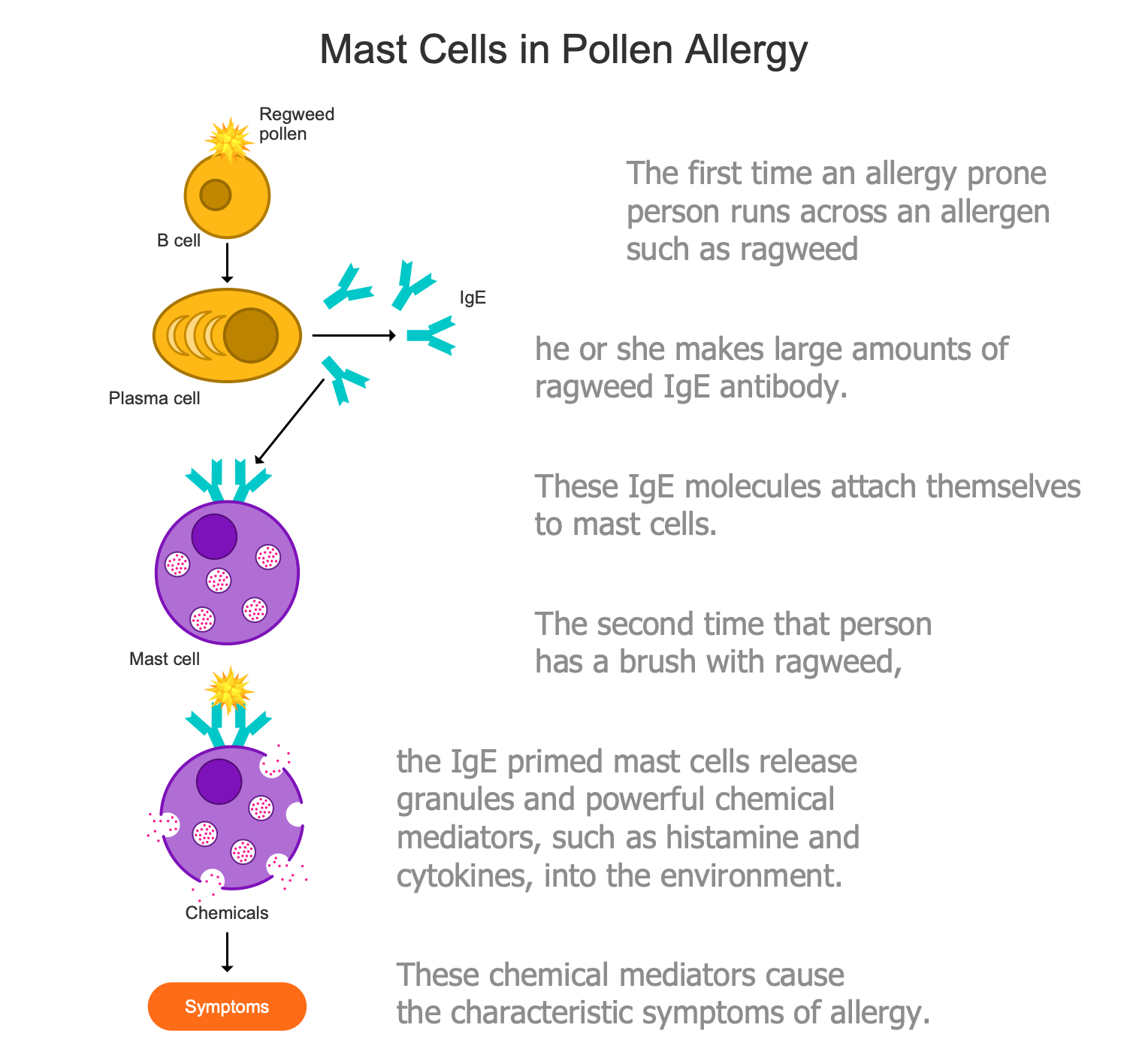
Example 13: RAST Test
This diagram was created in ConceptDraw DIAGRAM using the combination of libraries from the Allergology Solution. An experienced user spent 10 minutes creating this sample.
This sample is dedicated to the radioallergosorbent test (RAST). It is a blood test used to detect the sensitivity to the suspected or known allergen. RAST is a very susceptible method but expensive. It is recommended for use in cases when skin tests are impossible to be performed, for example, for children with severe eczema or in case of risk of an anaphylactic reaction. The RAST mechanism consists of the identification of specific IgE antibodies to allergens by means of the use of radioimmunoassay. A presence of IgE directed against some substance indicates the allergy to that substance. RAST allows measuring even the lowest IgE concentrations. A radioactive label is added to a small blood sample and allows identifying the presence of specific IgE antibodies in the blood. The allergens in the blood sample are bound to the special radio-labeled anti-IgE antibodies. Their level is measured using a radiation meter. Based on these measurements, the level of IgE antibodies in the patient's blood is evaluated.
Example 14: Signs of Anaphylaxis
This diagram was created in ConceptDraw DIAGRAM using the combination of libraries from the Allergology Solution. An experienced user spent 15 minutes creating this sample.
Anaphylaxis is a serious, rapidly developing allergic reaction. Symptoms appear within minutes or hours and can be fatal. On average, with intravenous exposure, minutes are observed, and with the use of foods caused the allergies, hours. This sample shows the main signs of anaphylaxis from various body systems like the respiratory, central nervous system, gastrointestinal tract, heart and vasculature, skin and others. Among the main signs are itchy rash, hives, runny nose, conjunctival edema, redness, shortness of breath, cough, wheezing or stridor, vomiting, swelling of the lips, throat and / or tongue, dizziness, loss of consciousness, weakness, blood pressure and more. More rarely, vomiting, diarrhea, pelvic pain, and loss of bladder control are observed. Common causes of anaphylaxis include insect bites, food, and medications. Primary treatment includes a horizontal position of the person, injection of epinephrine into the muscle, intravenous fluids, and the additional use of antihistamines and steroids.
Example 15: Tissues Affected in Allergic Inflammation
This diagram was created in ConceptDraw DIAGRAM using the combination of libraries from the Allergology Solution. An experienced user spent 15 minutes creating this sample.
Allergic inflammations like atopic dermatitis, allergic rhinitis, allergic asthma, ocular allergy reactions are the key pathophysiological features of a set of diseases. This diagram shows tissues affected by allergic inflammation immediately following an allergic reaction. Epithelial cells, immune cells, nerve cells, fibroblasts are affected. B cells and mast cells are involved in processes associated with allergic reactions. Penetrating cells due to allergic reactions contain a large number of white blood cells like neutrophils and eosinophils producing cytokines. As a result of an allergic reaction, histamine and proteins are released from mast cell granules, leukotrienes, prostaglandins and cytokines are produced, and allergen-specific IgE molecules bind to mast cells. These mediators act on nerve and other cells and cause unpleasant effects like itching, mucus secretion, vasodilation, edema and muscle contraction. Accurate allergy-related images and allergen pictograms helped make this diagram clear, understandable, and attractive.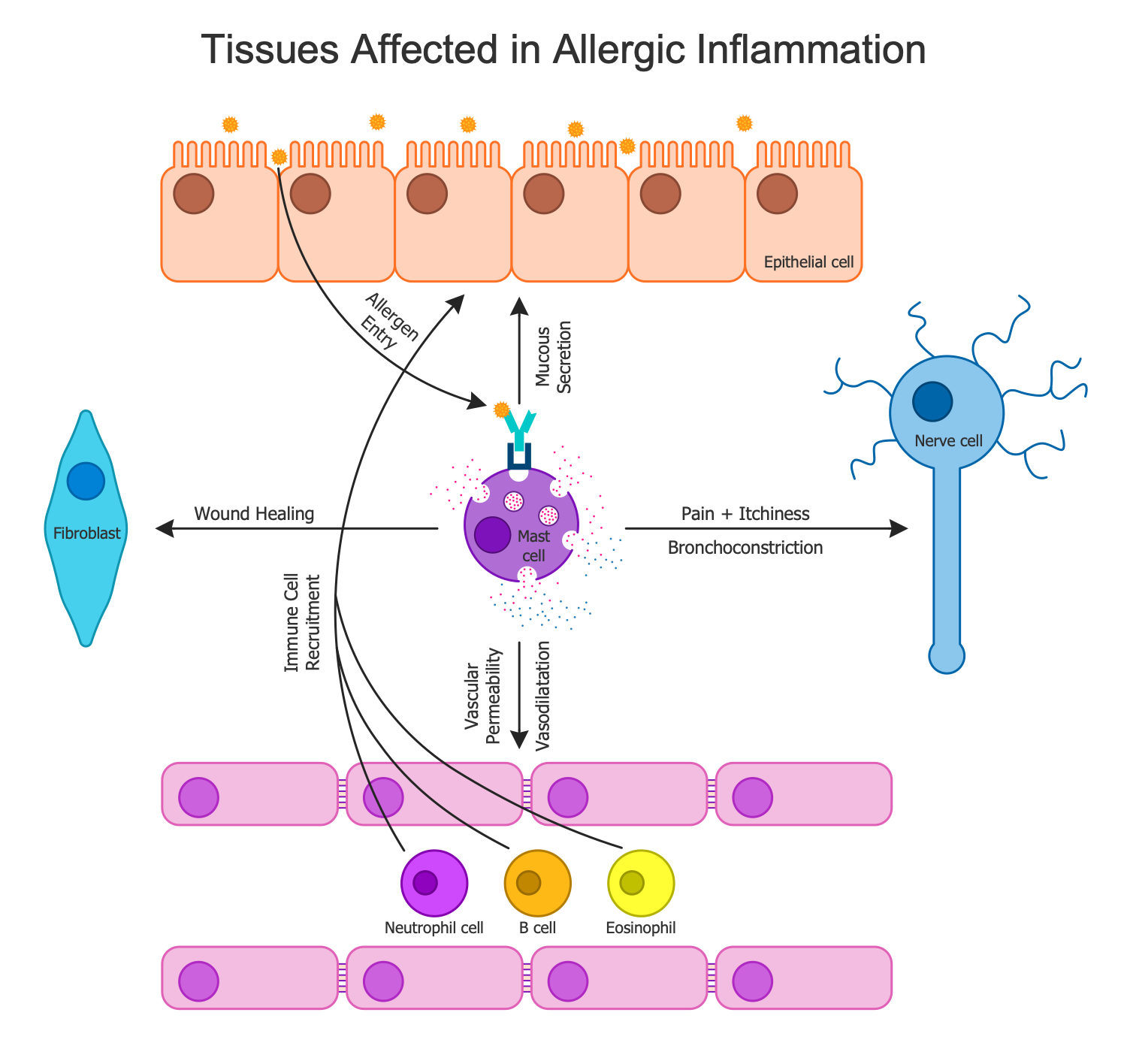
Inside
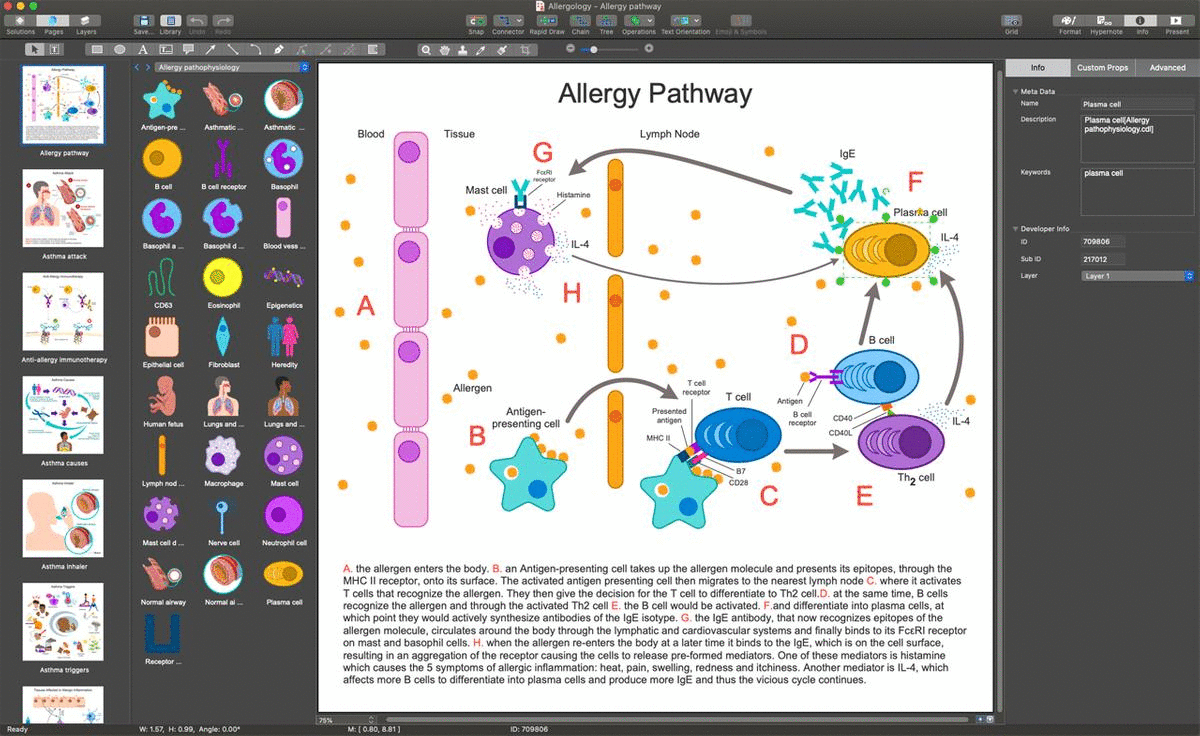
What I Need to Get Started
After ConceptDraw DIAGRAM is installed, the Allergology solution can be purchased either from the Health area of ConceptDraw STORE itself or from our online store. Thus, you will be able to use the Allergology solution straight after.
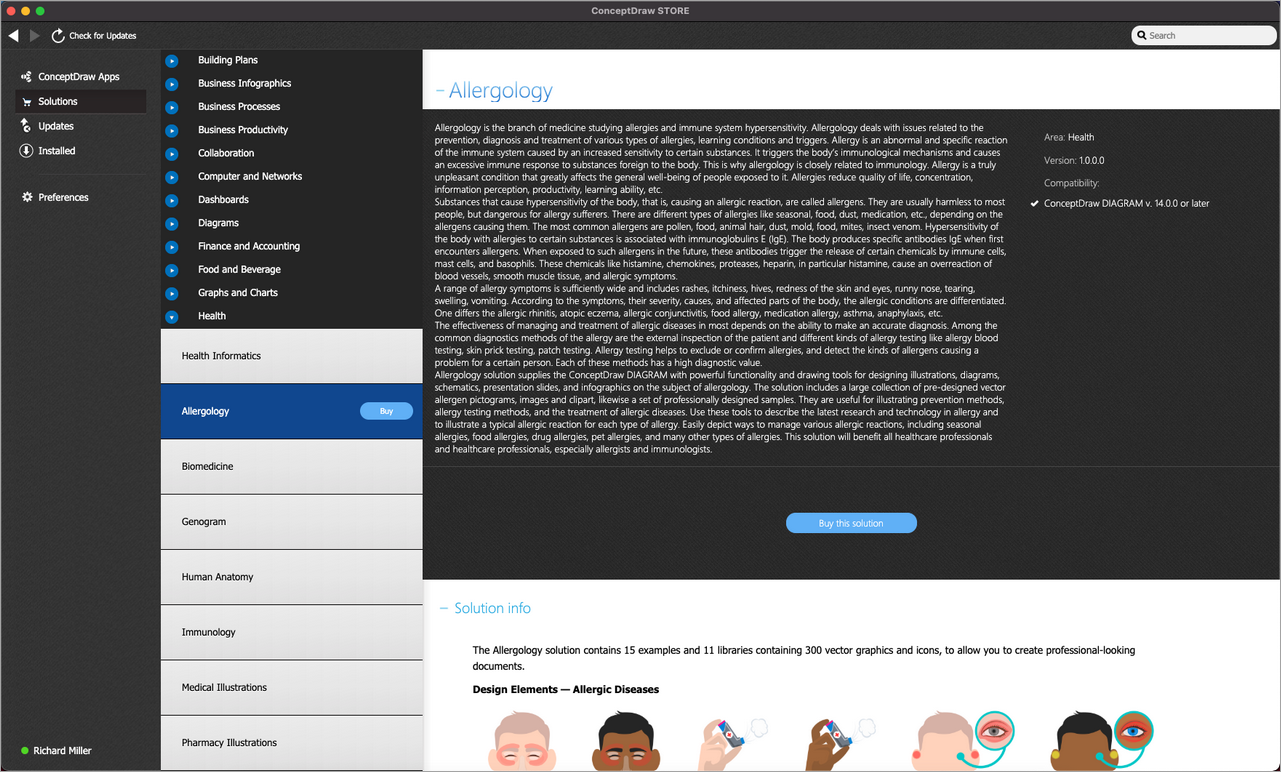
How to install
First of all, make sure that both ConceptDraw STORE and ConceptDraw DIAGRAM applications are downloaded and installed on your computer. Next, install the Allergology solution from the ConceptDraw STORE to use it in the ConceptDraw DIAGRAM application.
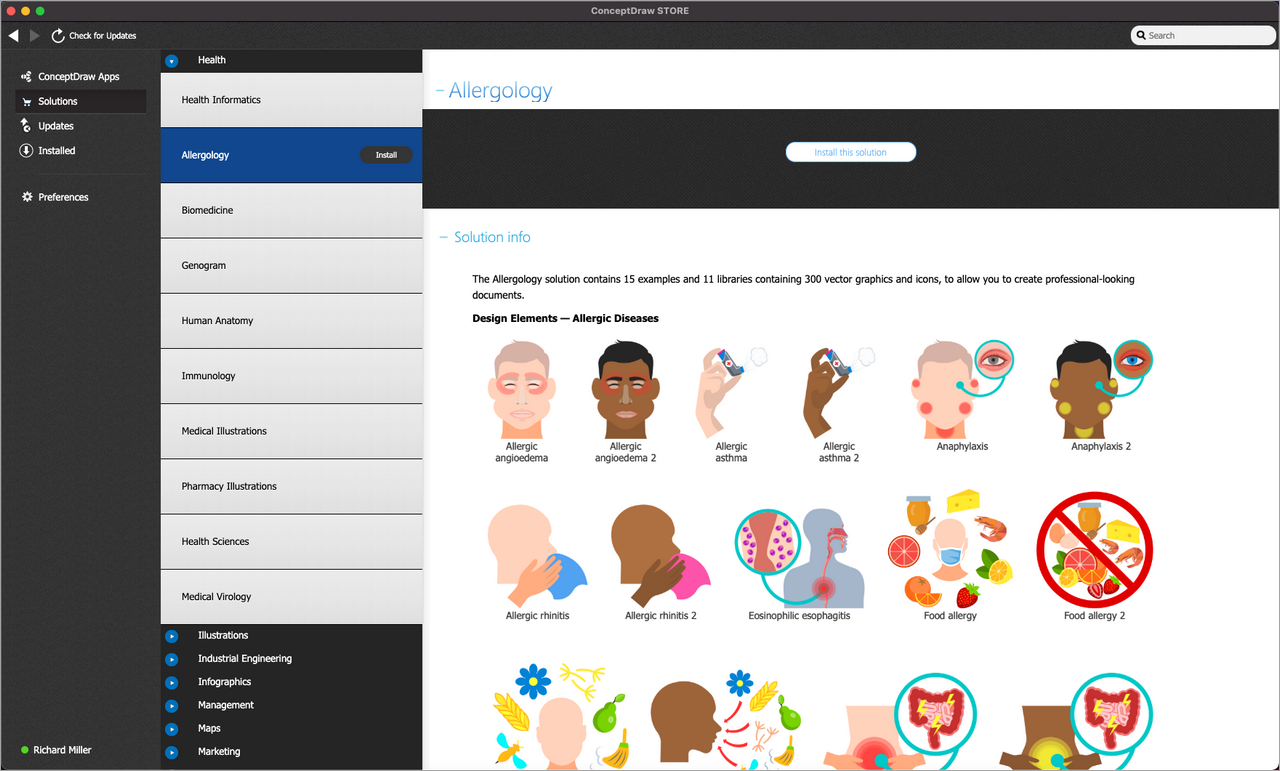
Start using
Start using the Allergology solution to make the professionally looking illustrations by adding the design elements taken from the stencil libraries and editing the pre-made examples that can be found there.
